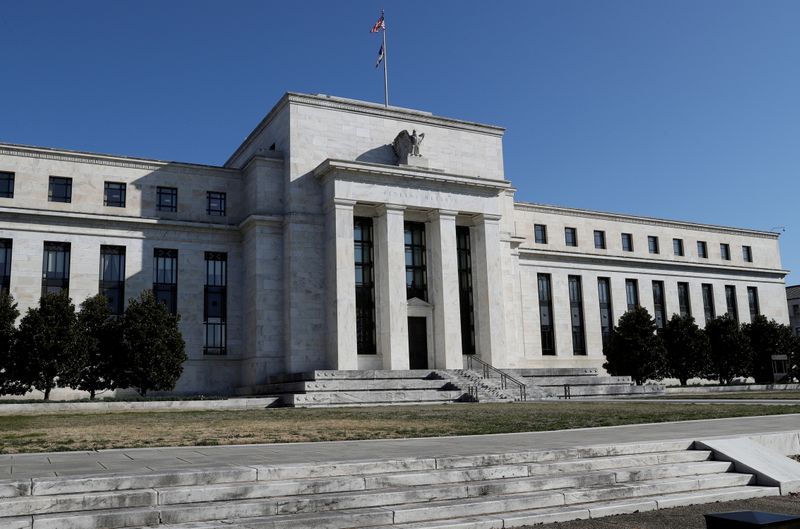By Howard Schneider and Ann Saphir
WASHINGTON/SAN FRANCISCO (Reuters) - A U.S. Federal Reserve divided over how to respond to fast-rising prices meets this week with the fresh complication of increased coronavirus infections and a global supply chain that, far from sorting out its problems, may be headed for more inflation-inducing trouble.
Fed officials are likely to affirm after their two-day meeting that a strong U.S. recovery and their planning for an eventual policy shift both remain underway. But the new risks, threatening the twin ills of slowed growth and higher prices, mean the rosy future seen in June seems less assured.
Debate over how to shape post-pandemic monetary policy has just begun, and decisions were not expected before the fall.
But since the Fed met just six weeks ago, what had seemed a blue-sky setting for that debate has become clouded by a quadrupling of daily infections led by the more-contagious Delta variant to levels approaching those seen in last summer's virus surge.
Even if the worst of the new outbreak is concentrated among less-vaccinated communities, economists see it potentially changing consumers' willingness to spend and travel, and say it will likely require the Fed to strike a balance between keeping faith in the recovery while taking explicit stock of what could go wrong.
So far, the risks to growth remain just that: Data on air travel and restaurant visits show consumers are still in recovery mode, not hunkering down.
A new policy statement is to be issued Wednesday at 2 p.m. (1800 GMT) followed by a press conference by Fed Chair Jerome Powell.
"Again and again we’ve seen over the last 18 months that the No. 1 determinant of economic activity is the virus," said Karen Dynan, a Harvard University economics professor and former assistant U.S. Treasury Secretary. "I think that we will continue to make forward progress, but that progress will be slower than otherwise.”
Developments since the last meeting "strengthened the case against pulling back on accommodation prematurely," given the new uncertainty about the recovery and despite higher-than- expected June inflation, Goldman Sachs (NYSE:GS) economist David Mericle wrote.
The Fed continues to buy $120 billion in government bonds each month and hold its policy interest rate near zero, measures rolled out in the spring of 2020 to buttress the economy from the pandemic. Some Fed officials already feel it is time to pivot from those policies because of the unexpected pace of recent price increases, and trading in bond markets in recent weeks showed investors betting the Fed may have to accelerate its exit from the crisis programs.
SUPPLY ISSUES 'NOT GOING ANYWHERE'
Yet it is, indeed, a long list of new problems that have arisen since June 16, when the Fed expressed confidence the pandemic was fading and that "progress on vaccinations will likely continue to reduce the effects of the public health crisis on the economy."
The rise of infections could, if it continues, weigh on the recovery, and would do so at a particularly tenuous moment.
The Fed is still hoping the economy can regain all of the 6.8 million jobs missing since the start of the pandemic, but that depends on other aspects of the recovery continuing apace - particularly a full reopening of public schools in the fall. That's anticipated to help free parents to return to jobs, but the process could be set back if the health crisis intensifies again.
Any slowdown in the recovery or hiring, meanwhile, would occur amid the expiry of the federal spending and benefits that sustained personal incomes last year, a "fiscal cliff" already expected to slow annual economic growth from its current high-octane pace of around 7%.
Rising inflation had been the immediate focus of Federal Reserve officials in recent weeks, cleaving the central bank between those worried prices may be increasing too fast and those arguing that the economy needed much more time to grow and regain lost jobs before any change in monetary policy.
Powell was peppered with questions about that politically sensitive subject during recent hearings on Capitol Hill. The issue is being watched carefully at the White House as well, with both the core of Fed officials and the Biden administration saying they remain convinced current price increases are mostly the result of a complicated economic reopening and will ease on their own.
There may be new reason to doubt. A collision of events, including floods in Germany and China, are again clogging the flow of parts and materials around the world, prolonging the supply bottlenecks that Fed officials and the White House have counted on getting resolved to help ease price pressures.
"Supply-side issues are clearly not going anywhere," Citi economists wrote on Friday. "Costs from inputs and supplier wait times are likely to continue appearing in consumer inflation for months to come."
From a relatively straight-forward and even somewhat old-fashioned dilemma in June - was inflation too high or not? - the Fed now "has risks in two directions," said former Fed monetary policy director and Yale School of Management professor William English, with the likelihood of more embedded inflation now running alongside risks to growth and the waning of federal fiscal support.
"Things could play out in a way they didn't expect," English said.
